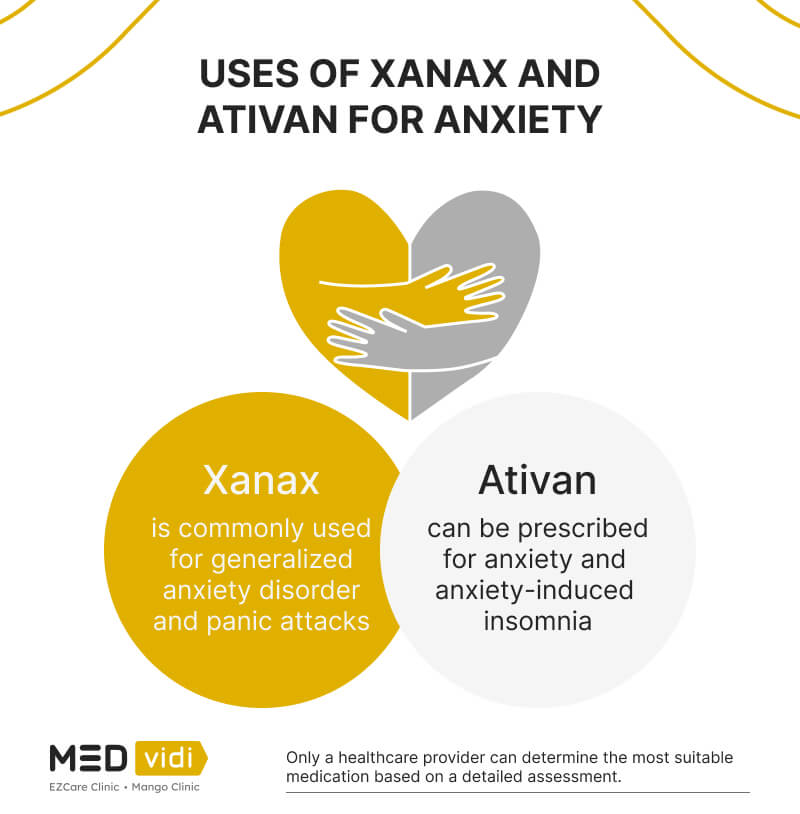When it comes to managing anxiety disorders, medications like Xanax and Ativan are frequently prescribed to provide relief. They can help reduce anxiety and promote relaxation by affecting certain neurotransmitters in the brain. However, despite their similarities, these medications have distinct features in terms of potency, onset of action, and potential side effects.
In this article, we will delve into a comparative analysis of Xanax and Ativan. You can learn more about their respective strengths, differences, and effects, assisting you in having an informed conversation with your healthcare provider and asking important questions about your treatment plan and alternatives beforehand.
To receive a personalized plan for anxiety treatment from an online doctor, click the button below.
What Are Ativan and Xanax?
Uses and Dosage of Lorazepam and Alprazolam
In addition to anxiety management, Ativan is FDA-approved for short-term treatment of anxiety-induced insomnia. It is also used in hospitals to reduce pre-surgery anxiety and to induce sedation. On the other hand, Xanax may be prescribed for insomnia off-label and is primarily used to treat panic and anxiety disorders.
The dosage of Ativan and Xanax depends on the particular condition being addressed, the severity of symptoms, the patient’s overall health status, and their response to treatment. The initial recommended dose of Ativan for adults dealing with anxiety ranges from 2 mg to 3 mg per day. For managing insomnia associated with anxiety or short-term situational stress, a single daily dose of 2 to 4 mg can be prescribed, preferably at bedtime.
The initial dose of Xanax prescribed to adults diagnosed with an anxiety disorder generally falls between 0.25 mg and 0.5 mg daily. When addressing panic disorders, the starting dosage is typically around 0.5 mg, taken three times per day. Based on the response to the medication, the doctor may gradually modify the dosage to reach the desired effects.
It’s important to highlight that both Ativan and Xanax are designed for short-term utilization, and extended usage can result in dependency and withdrawal symptoms. Additionally, they might interact with other medications you may be taking, underscoring the importance of keeping your healthcare provider informed about all your current medications.
Note that the above-mentioned dosages are general and cannot be taken as guidance because the instructions are provided for each patient individually based on their symptoms, health history, reaction to the medication, and other aspects. Adherence to the prescribed regimen is crucial, and abrupt cessation of this medication should be avoided to prevent potential severe withdrawal symptoms.
Below, you will find a comparison table highlighting the main characteristics of these two medications.
Ativan | Xanax | |
|---|---|---|
Generic name | Lorazepam | Alprazolam |
Drug class | Benzodiazepine | Benzodiazepine |
Drug schedule | Schedule IV | Schedule IV |
Uses | Acute anxiety symptoms and panic disorder | |
Side effects | Drowsiness and fatigue, dizziness, loss of coordination, nausea and constipation, changes in appetite | Drowsiness and fatigue, dizziness, lack of coordination, gastrointestinal issues |
Xanax vs Ativan: Key Differences
Though both Ativan and Xanax are benzodiazepines and are commonly used to treat anxiety disorders, they have significant differences in their onset of action, duration of effect, specific uses, etc.
Onset and Duration of Action
Xanax is renowned for its fast-acting nature, compared to some other medications for anxiety. It tends to start working within the first hour after consumption (note that the onset time may differ because of individual factors). This makes it particularly useful for delivering relief during severe episodes of anxiety or panic attacks. However, its effects typically fade within a few hours.
Conversely, Ativan does not start working as promptly as Xanax, but its impact is more sustained. Ativan’s effects usually kick in between 1 to 3 hours after intake and can persist for up to 8 hours or even more, depending on individual factors. This extended duration of effects usually positions Ativan as a more suitable choice for handling persistent, ongoing anxiety. However, the final choice of medication may differ based on the person’s symptoms and health history.
Uses
Both Xanax and Ativan serve as medications for anxiety, yet they possess distinct advantages. Xanax is particularly useful for addressing acute anxiety symptoms and panic attacks. On the other hand, Ativan, characterized by its extended duration of effect compared to Xanax, is commonly prescribed for generalized anxiety disorder. It is also frequently used to manage insomnia triggered by anxiety. In hospital scenarios, Ativan is also routinely used to calm patients before surgery and treat severe symptoms of alcohol withdrawal.
Sedation and Performance Impact
Ativan and Xanax both carry the potential for inducing sedation and performance disruption. However, Ativan is typically viewed as having a greater sedative effect compared to Xanax. As a result, Ativan could potentially lead to a higher incidence of sleepiness, whereas Xanax might be more likely to result in coordination challenges and cognitive impairment.
Half-life of Xanax vs Ativan
A medication’s half-life pertains to the time it takes for its concentration in the bloodstream to decrease by half. This aspect influences the duration of the medicine’s effects and dosage instructions. Also, the half-life plays a role in the potential for dependency and severe withdrawal symptoms, with medications possessing shorter half-lives possibly posing an increased risk.
In healthy adults, the estimated half-life of Xanax spans from 11 to 16 hours. In contrast, Ativan possesses a somewhat lengthier half-life, generally from 12 to 20 hours, depending on the formulation. Prolonged use of both Xanax and Ativan can lead to physical and psychological reliance.
Connect with a certified mental health professional to know what treatment can help you best.

Xanax vs Ativan: Similarities
Xanax (alprazolam) and Ativan (lorazepam) share several essential similarities, as they both belong to the benzodiazepine class of medications and are commonly prescribed to treat anxiety and panic disorders. Here are the key similarities between Xanax and Ativan.
Drug Class
Both Xanax and Ativan are benzodiazepines and work by enhancing the effects of gamma-aminobutyric acid (GABA) in the brain.
Uses
Xanax and Ativan are primarily prescribed for the treatment of anxiety disorders. They are effective in managing excessive worry, restlessness, and nervousness. Additionally, they can help alleviate panic attacks—sudden, intense fear episodes accompanied by physical symptoms, such as a rapid heartbeat and shortness of breath.
Duration of Use
Xanax and Ativan are typically prescribed for short-term use because prolonged usage increases the risk of physical and psychological dependence. They are often prescribed for brief periods to manage acute symptoms. Other long-term strategies for anxiety management may be recommended in conjunction with these medications.
Side Effects
As benzodiazepines, Xanax and Ativan share some adverse effects, such as drowsiness, dizziness, blurred vision, and impaired coordination. They may also cause memory issues and cognitive difficulties, particularly at higher dosages.
Possible Side Effects
Ativan
As with any medication, Ativan can trigger side effects. While not everyone taking Ativan will experience these effects, it’s essential to be mindful of possible side effects.
- Drowsiness and fatigue. Since the primary effect of Ativan is calming the central nervous system, it can result in drowsiness and fatigue. It is a common adverse effect of Ativan at the start of treatment and it often diminishes with time.
- Dizziness. Some people may experience light-headedness, especially when quickly standing up from a seated or lying position. It’s recommended to rise slowly to reduce the risk of dizziness or potential fainting.
- Loss of coordination. Ativan can interfere with motor skills, potentially causing unsteadiness or coordination difficulties. Therefore, driving or operating heavy machinery can become dangerous.
- Nausea and constipation. Ativan may cause gastrointestinal issues, such as nausea or constipation, particularly during the initial stages of use.
- Changes in appetite. Some people may notice changes in their appetite when taking Ativan, which can lead to weight changes, either gain or loss.
Ativan can cause severe side effects like confusion, hallucinations, mood alterations, speech difficulties, changes in vision, unusual weakness, and more. Any occurrence of these symptoms should be immediately communicated to a healthcare provider.
Xanax
Adverse effects of Xanax typically occur at the onset of treatment and often fade with time on their own. However, if these symptoms are prolonged or bother you for another reason, consider consulting with a healthcare provider.
Some of the most common side effects associated with Xanax are the following:
- Drowsiness and fatigue. As a sedative medication acting on the central nervous system, Xanax can often cause drowsiness. This effect tends to be more pronounced at the beginning of treatment and typically decreases with continued use.
- Dizziness. As with Ativan, those who take Xanax are subjected to dizziness or light-headedness. To minimize this potential negative effect, especially when getting up from sitting or lying down, it’s recommended to stand up gradually.
- Lack of coordination. Xanax can impair motor skills, which may impact activities like driving or operating machinery that require alertness.
- Gastrointestinal issues. People taking Xanax can experience gastrointestinal problems such as nausea, upset stomach, dry mouth, increased salivation, or constipation.
Xanax may also trigger serious side effects such as disorientation, visual or auditory misperceptions, behavioral or mood shifts, speech difficulties, memory issues, or unexpected weakness. If any of these conditions arise, it’s imperative to reach out to a healthcare professional promptly.
Drugs Interactions
As both Xanax and Ativan belong to the benzodiazepine family, they share potential drug interactions.
Opioids[6] . Co-administration with opioids (morphine, oxycodone, codeine, etc.) can lead to profound sedation, respiratory depression, coma, and even death due to combined CNS depressant effects.- Alcohol and other CNS depressants. Alcohol and other substances that depress the central nervous system can interact with Xanax and Ativan. It increases the risk of drowsiness, slowed breathing, and potentially fatal respiratory depression.
- Sedatives and hypnotics. Medications such as barbiturates, sedative antihistamines, and sleep aids can enhance the soothing effects of both Xanax and Ativan, increasing drowsiness and potentially causing respiratory depression.
- Antipsychotics. The simultaneous use of antipsychotic medications may amplify the sedative effects of both Xanax and Ativan and could increase the risk of respiratory depression.
- Antifungal medications. Medications like ketoconazole and itraconazole may elevate the levels of Xanax and Ativan in the body, potentially leading to increased side effects.
- Antidepressants. Certain antidepressants have the potential to heighten the sedative impact of both Xanax and Ativan, which could result in increased sleepiness and potentially other undesired effects.
Schedule a virtual appointment and receive personalized treatment for anxiety.
Ativan (Lorazepam) versus Xanax (Alprazolam): Warnings
Besides drug interactions, there are important warnings to consider when taking Ativan or Xanax.
- Ativan and Xanax addiction. Prolonged use of these medications can result in physical and psychological addiction. Abrupt discontinuation of these medications may cause withdrawal symptoms like agitation, sleep disturbances, and, in extreme situations, seizures.
- Use during pregnancy. Both Xanax and Ativan are classified as Category D drugs during pregnancy, indicating scientific evidence of potential risks to the fetus based on adverse reaction data. These medications should only be considered during pregnancy if the anticipated benefits outweigh the possible hazards to the unborn child.
- Elderly or debilitated patients. Use of both Xanax and Ativan in elderly or debilitated patients should be with caution, as they may be more sensitive to the sedative effects of these medications, which can increase the risk of falls.
- Administration to patients with respiratory conditions. Xanax and Ativan, both capable of inducing respiratory depression, should be administered cautiously to patients with respiratory disorders, such as chronic obstructive pulmonary disease (COPD) or sleep apnea.
Ativan vs Xanax: Which Medication Is More Effective for the Treatment of Anxiety?
The effectiveness of the same medication varies from one patient to another since there is no one-size-fits-all treatment for anxiety. The choice of the most suitable option isn’t a straightforward process, as the effectiveness of each medicine can significantly differ based on such individual factors as the specific type of anxiety disorder, the severity of symptoms, the individual’s overall health, medical history, and their response to medication.
Xanax tends to act faster and has a short duration of action, which makes it particularly useful for providing relief during acute episodes of anxiety and panic attacks. However, due to its relatively short half-life, it may require more frequent dosing, and there may be a higher risk of experiencing withdrawal symptoms upon discontinuation.
On the other hand, Ativan has a slightly longer onset of action but a longer duration of effect. This means that it might be more suitable for managing persistent anxiety over a more extended period. Its longer half-life also means it may require less frequent dosing, which can be more convenient for some individuals.
Regarding overall value as anxiety medications, both Ativan and Xanax have been found to be highly effective and generally well-tolerated. There is no significant difference in their effectiveness for the treatment of acute anxiety symptoms, and the most appropriate option should be determined by a healthcare provider based on a detailed assessment.
In Conclusion
When examining Xanax versus Ativan in terms of strength, differences, and effects for sleep and anxiety, it becomes clear that both medications have their unique advantages and potential drawbacks, while there is no significant difference in their effectiveness. Based on important details, such as symptoms, medication specifics, and health history, a healthcare provider can select the most appropriate option from a variety of anxiety medications. Book your video visit with a licensed healthcare professional to get your symptoms assessed and receive a personalized treatment plan online.
FAQ
What is 1mg of Ativan equivalent to Xanax?
Typically, a dosage of 0,5 mg of Xanax is perceived as equivalent to 1 mg of Ativan. However, note that it’s important to stick to the medical provider’s instructions and take the prescribed medication. The change is possible only after a consultation with a healthcare specialist.
Is Ativan stronger than Xanax?
Neither medication is more potent than the other, so it’s impossible to state if Ativan is better than Xanax or vice versa. Patients can respond to the same treatment differently, so it’s important to receive personalized recommendations from a healthcare professional.
Does Xanax or Ativan make you more sleepy?
Both Xanax (alprazolam) and Ativan (lorazepam) are benzodiazepines, a class of drugs known for their sedative effects, which means they can both make you feel sleepy. Ativan is used more commonly for inducing sleep or reducing anxiety since it’s FDA-approved for insomnia treatment. However, Xanax can be prescribed for insomnia off-label too.
Can I use Ativan or Xanax while pregnant?
Both Xanax and Ativan fall under Category D medications during pregnancy, suggesting that there’s scientific proof of potential harm to the developing fetus based on adverse reaction data. If you’re pregnant or planning to become pregnant, you should discuss your anxiety treatment options with your healthcare provider.
If you’re currently using Ativan or Xanax and become pregnant, do not stop taking the medication without first consulting with your healthcare provider due to the risk of withdrawal symptoms.
Can I use Ativan or Xanax with alcohol?
Combining Ativan or Xanax with alcohol is not recommended. Both meds are benzodiazepines, a class of drugs that slow down the central nervous system. Alcohol also depresses the CNS. When you combine Ativan or Xanax with alcohol, the effects of both substances can intensify, potentially resulting in severe side effects, including:
- Increased drowsiness, dizziness, and risk of accidents.
- Severe confusion, unsteady movement, or memory problems.
- Slowed or difficulty breathing, which can be life-threatening.
Can I go from Xanax to Ativan?
Transitioning from Xanax to Ativan is possible, but it should only be done under the supervision of a healthcare provider. Both medications are benzodiazepines and have similar effects, but their dosages, half-lives, and individual patient reactions can vary.
Which is longer-acting lorazepam or alprazolam?
Lorazepam is generally considered to be longer-acting compared to alprazolam. This is due to differences in the half-life of the two drugs.













